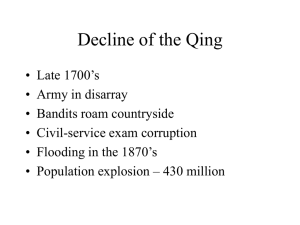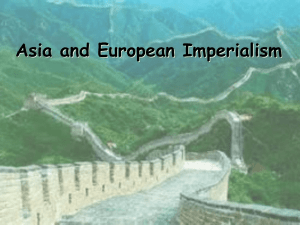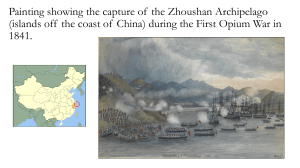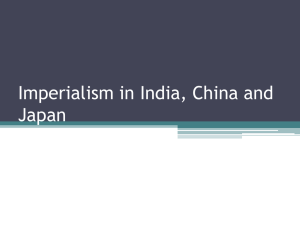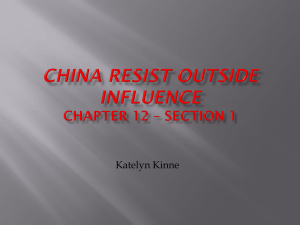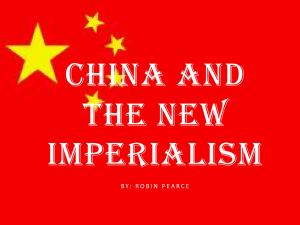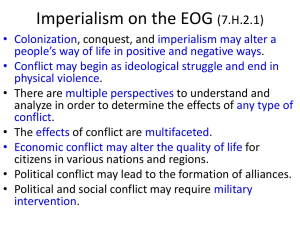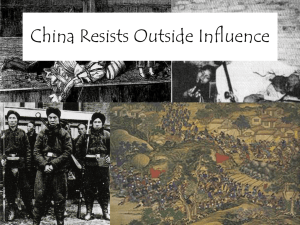China and the New Imperialism
advertisement
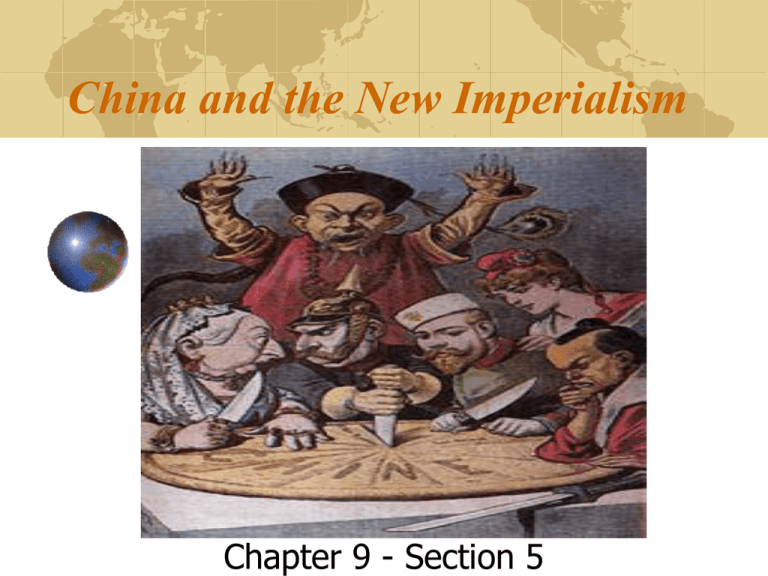
China and the New Imperialism Chapter 9 - Section 5 Key Terms 1. 2. 3. 4. 5. 6. 7. 8. 9. 10. 11. 12. balance of trade trade surplus trade deficit Opium War indemnity extraterritoriality Taiping Rebellion Sino-Japanese War Open Door Policy Guang XU Boxer Uprising Sun Yixian The Opium War The Opium War During the late 1700s, British merchants made huge profits by trading opium grown in India for Chinese tea. Soon, many Chinese became addicted to opium. Silver flowed out of China, causing the Economy to fail. The Chinese government outlawed opium and executed drug dealers. Britain refused to stop, insisting on the right to free trade. In 1839, Chinese warships clashed with British merchants, triggering the Opium War. British gunboats, equipped with the latest in firepower, crushed China’s coast, and easily defeated the Chinese. The Treaty of Nanjing In 1842, Britain made China accept the Treaty of Nanjing. Britain received a huge indemnity, or payment for losses & costs in the war. The British also gained the island of Hong Kong. China had to open five ports to foreign trade and grant British citizens in China extraterritoriality, the right to live under their own laws and be tried in their own courts. The treaty was a series of “unequal treaties” that forced China to make concessions to Western powers The Taiping Rebellion The Taiping Rebellion The Taiping Rebellion lasted from 1850 to 1864, was probably the most devastating peasant revolt in history. By the 1800s, the Qing Dynasty was in decline due to poor irrigation systems, canals, flooding, and the population explosion. An extravagant imperial court, tax evasion by the rich, and official corruption added to the peasants’ burden. Poverty and misery increased causing peasants to revolt. Hong Xiuquan lead the revolt, and called for an end to the hated Qing Dynasty. The Taiping rebels won control of large parts of China for over 14 years, before the government crushed them. The Taiping rebellion almost toppled the Qing Dynasty. It is estimated that 20 to 30 million Chinese died during the rebellion. The Qing government survived, but had to share power with regional commanders, and Russia seized lands in the north. Launching Reform Acts Many Chinese scholar-officials disapproved of Western ideas since it challenged the Confucian order. In the late 1860s, reformers launched the “selfstrengthening movement” – which imported the latest Western technology to build factories and modern weapons. The movement made only limited progress because the government did not rally behind it. Japan rapidly modernized and took control of the island of Taiwan from China during the SinoJapanese War. Open Door Policy allowed all nations to openly trade in China. The United States feared European power in China. No Chinese were ever consulted. Hundred Days of Reform was launched by Guang Xu, a young emperor in 1898. New laws set out to modernize China. Conservatives soon rallied agianst the reform and Xu was imprisoned. Ci Xi, the aging empress reasserted control. All reformers fled! The Boxer Uprising The Boxer Uprising 1. 2. 3. 4. 5. 6. What led to the Boxer Uprising? Who were the Chinese secret society? Why were they called Boxers? What was the goal of the Boxers? What happened in the Boxer Uprising? What was the aftermath of the Boxer rebellion? Three Principles of the People Sun Yixian, a passionate spokesman for a Chinese Republic, organized the Revolutionary Alliance to rebuild China on “Three Principles of the People” 1. Nationalism, freeing China from foreign domination. 2. Democracy, or representative government. 3. Livelihood, or economic security for all Chinese. Birth of a republic began when Ci Xi died in 1908 and a two-year-old boy inherited the throne. China slipped into chaos, and in 1911, uprisings spread to man provinces. Peasants, students, local warlords helped topple the Qing Dynasty. December 1911, Sun Yixian was named president of the new Chinese republic.
